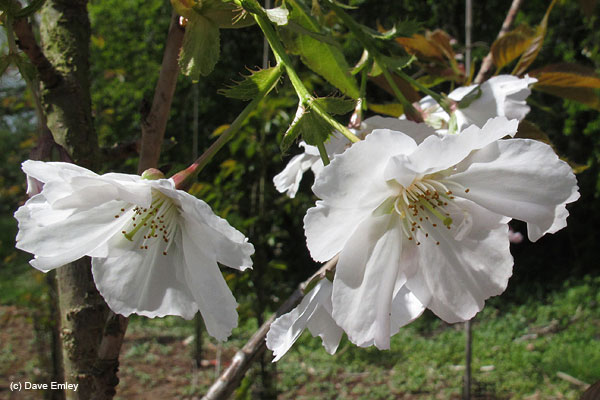Species and varieties in the National Collection of Flowering Cherries at
Keele University
Prunus 'Senriko'
Sato-zakura Group

‘Senriko’ forms a medium-sized umbrella shaped tree. Leaves open yellowish green, maturing to deep green; they are large.
From pale pink buds, the large 4.5-5.5 cm (c. 2") dia. flowers open white. They form nodding corymbs of 3 to 6 blooms, both single and double, with the petals much ruffled. Flowers open fairly late in Japan -mid-late April to mid May in Japan. They are said to be strongly fragrant, hence the Japanese name. Peduncles are 4 cm (c.1.7") long and pedicels 3-3.6 cm (c.1.5") long.
In the C19, ‘Senriko’ featured commonly on the Arakawa River Bank in Tokyo, planted in the Meiji Period (1868 - 1912). Its name in Japanese means ‘the thousand mile fragrance’ - a fanciful reference to the strength of its scent. It very closely resembles two other sato-zakura - ‘Ojochin’ and ’Ariake’. Collingwood (Cherry) Ingram (1948) regarded it as synonymous with ‘Ojochin’. More recently, Kuitert (1999) considered that it resembles ‘Ariake’ in the smallest detail. He mentions its similarity to ‘Ojochin’ but considers the latter distinct as it has no fragrance.
A recent extensive study of the DNA patterns of Japanese Cherry cultivars has shown that ‘Senriko’, ‘Ojochin’, and ‘Ariake’ cultivars to be indistinguishable (Kato et al. 2012, 2014). Both appear to be mainly derived from the wild cherry species Prunus speciosa and Prunus jamasakura with some input from Prunus incisa.
Triploid set of chromosomes (2n = 24).
Location
- One in the Memorial Garden; square K11; tag 4255; planted 2012.

